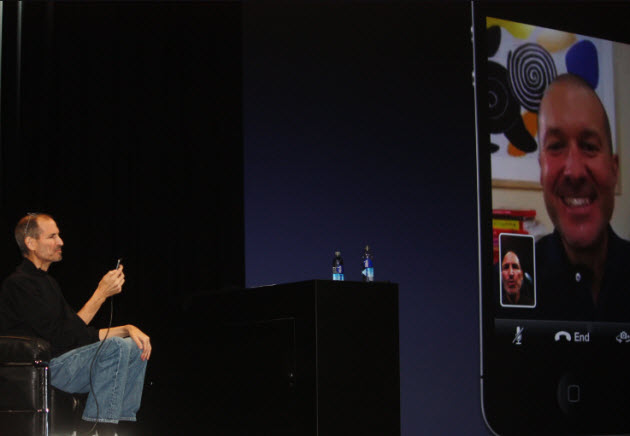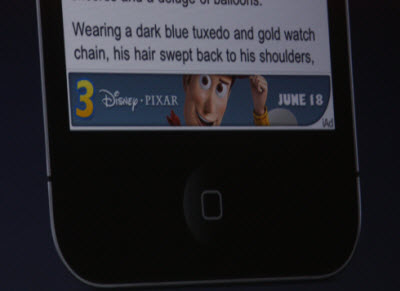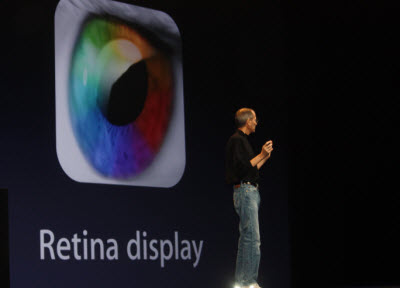 Steve Jobs showed today why Apple is innovative enough to stay ahead of the pack of companies that want to clone the magic of the iPhone.
Steve Jobs showed today why Apple is innovative enough to stay ahead of the pack of companies that want to clone the magic of the iPhone.
 With the iPhone 4, Apple is going to have a headstart on its rivals again. How much of a headstart remains to be seen. But many of the features that Apple showed today at its Worldwide Developer Conference in San Francisco are unique to the iPhone.
With the iPhone 4, Apple is going to have a headstart on its rivals again. How much of a headstart remains to be seen. But many of the features that Apple showed today at its Worldwide Developer Conference in San Francisco are unique to the iPhone.
Apple continues to set the pace for others to follow. The question is, are Apple’s devices innovative enough to stay ahead of rivals such as phones based on Google’s Android operating system?
The FaceTime video call feature is perhaps one of the biggest advances that Jobs showed off this morning. It uses the iPhone’s high-definition video cameras to shoot high-quality video in the H.264 format. As long as the WiFi wireless data networks can support it, this is a great feature.
Apple will clearly not be the only phone maker to offer video calls. It is sharing FaceTime as a standard so that people with iOS4 (formerly called the iPhone 4 operating system) devices can make video phone calls with anyone who has a video phone device. That benefits Apple, since the more people you can call, the more you will use the feature. But  Apple has executed on this feature elegantly. You simply tap on the phone call icon on an iPhone. Then you dial one of your contacts. If that person has an iPhone 4 as well, you can tap the FaceTime button. Then a call just starts. That’s a pretty simple way to do video phone calls.
Apple has executed on this feature elegantly. You simply tap on the phone call icon on an iPhone. Then you dial one of your contacts. If that person has an iPhone 4 as well, you can tap the FaceTime button. Then a call just starts. That’s a pretty simple way to do video phone calls.
Is this a killer application? Possibly. The calls use WiFi only, so they are not subject to the data limits that AT&T just put on its data plan subscribers, who will now pay $25 for 2 gigabytes a month of data. If you used your phone’s data connection to watch just 200 minutes of video, you would hit the two gigabyte limit. But since this is on WiFi, it won’t contribute to your data usage.
Based on a video Apple showed today, the company knows how to market this advantage, showing off video calls of couples viewing the ultrasound images of their baby in the mother’s womb. Those ads are emotional tear jerkers and they could create a lot of demand for the video phone feature.
 Apple’s iAds feature also looks like it will open up a brand new revenue stream for rich media ads on iPhone 4 devices. The iAds can be customized to include graphics, video, and interactivity. In other words, the apps can look almost as good as an app and can thus be more engaging.
Apple’s iAds feature also looks like it will open up a brand new revenue stream for rich media ads on iPhone 4 devices. The iAds can be customized to include graphics, video, and interactivity. In other words, the apps can look almost as good as an app and can thus be more engaging.
Apple is taking a 40 percent cut of those ads and is selling them directly. Developers only need to note where the ad will be placed, and Apple will do the rest. Jobs said that in 8 weeks, Apple has booked $60 million worth of ads in the second half of the year. He said the company still has a lot more iAds to book. These ads let the user stay inside the app that they are viewing.
Others can duplicate this, as Google plans to do undoubtedly with its AdMob acquisition. But it’s another hurdle in the way of rivals, and it’s another benefit for Apple’s developers that will keep them glued to the iPhone platform. The iAds will debut on July 1.
 Apple also has a big advantage with its new screen, dubbed a Retina Display. This goes hand in hand with delivering clear video conferences, but it is also useful in viewing pictures, playing games, and running other visual apps on an iPhone. The Retina Display can put 326 pixels (the tiny dots, or picture elements, that make up an image on a screen) per square inch. That’s four times more dense than on an iPhone 3GS. Apple uses a specially coated glass to bring out the resolution, and it is using the same kind of IPS screens as the iPad uses. Jobs said it would likely be some time before anyone duplicates this kind of technology. I would love to see the Retina Display on the larger iPad devices. Games with four-times higher resolution would look extremely cool. One question I still have is whether Apple has improved the accuracy of touchscreens, which sometimes fail to detect a finger stroke.
Apple also has a big advantage with its new screen, dubbed a Retina Display. This goes hand in hand with delivering clear video conferences, but it is also useful in viewing pictures, playing games, and running other visual apps on an iPhone. The Retina Display can put 326 pixels (the tiny dots, or picture elements, that make up an image on a screen) per square inch. That’s four times more dense than on an iPhone 3GS. Apple uses a specially coated glass to bring out the resolution, and it is using the same kind of IPS screens as the iPad uses. Jobs said it would likely be some time before anyone duplicates this kind of technology. I would love to see the Retina Display on the larger iPad devices. Games with four-times higher resolution would look extremely cool. One question I still have is whether Apple has improved the accuracy of touchscreens, which sometimes fail to detect a finger stroke.
 The iMovie app for the iPhone 4 is also quite cool. Apple makes this software, and it gives you the ability to edit a movie from your raw iPhone video footage. You can edit a video using your own finger gestures in just a matter of minutes. You can add transition screens, video themes, music, and captions/titles without firing up a Mac. Software elegance is hard to duplicate, so this app could go a long way toward setting Apple’s devices apart.
The iMovie app for the iPhone 4 is also quite cool. Apple makes this software, and it gives you the ability to edit a movie from your raw iPhone video footage. You can edit a video using your own finger gestures in just a matter of minutes. You can add transition screens, video themes, music, and captions/titles without firing up a Mac. Software elegance is hard to duplicate, so this app could go a long way toward setting Apple’s devices apart.
The iPhone 4 is also using Apple’s A4 chip, the brain of the phone that also serves as the main processor in the iPad. This 1-gigahertz chip combines an ARM-based microprocessor and a graphics processor in the same chip. Rivals who don’t make their own chips may pay higher costs and might have to wait longer before they can get the same performance as is available in the Apple devices. This is a good advantage, but not necessarily a killer one.
 Also on the technical front, the iPhone will now have a chip-based gyroscope built into it. That means it will be much better at detecting motion and position compared to the accelerometer-based older iPhones. Jobs showed how he could turn the iPhone around and an object on the screen could rotate in 3D with him, perfectly in sync. This is another benefit for gamers who have become very attached to motion-sensing games and the touchscreen.
Also on the technical front, the iPhone will now have a chip-based gyroscope built into it. That means it will be much better at detecting motion and position compared to the accelerometer-based older iPhones. Jobs showed how he could turn the iPhone around and an object on the screen could rotate in 3D with him, perfectly in sync. This is another benefit for gamers who have become very attached to motion-sensing games and the touchscreen.
Finally, Apple’s devices are reasonably priced (and come in black or white). The iPhone 3GS with 16 gigabytes drops down to $99 with a two-year contract. A 16-gigabyte iPhone 4 is just $199 with a contract, and the 32-gigabyte version is $299. Apple’s pricing is falling within reach of mass market consumers who wouldn’t normally spend a lot on a phone. The new devices go on sale on June 24 and are available for preorder on June 15.
And Apple still has a lot of inherent advantages with its platform. There are now 225,000 apps available that have been downloaded almost 5 billion times. The revenue generated for the iPhone’s developers has crossed $1 billion. Pretty soon, Apple will have sold its 100 millionth iPhone operating system device. And there are more than 150 million existing iTunes accounts that have been used to make purchases on the AppStore. These are all barriers to entry, as Android still has less than 50,000 apps and no one has bragged much about how many Android apps they’re selling.
Perhaps the big limit on Apple’s potential will still be the one everyone complains about. It’s still an exclusive for AT&T and is not available on phone networks such as Verizon Wireless.

